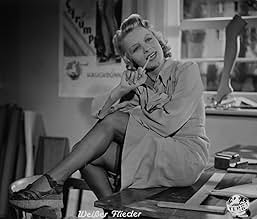Mady Rahl(1915-2009)
- Actress
- Soundtrack
Beautiful, smoky-voiced platinum blonde Mady Rahl was the 'Sportsmädel'
of the German cinema in the
1930's and 40's. During the war years, she
was touted in Nazi propaganda as an ideal of Germanic femininity. Her association with members of the regime, including the ever roving-eyed Joseph Goebbels,
damaged her career in the aftermath of World War II. Nonetheless, she
would reemerge in the 1950's as a more versatile actress, if not a
bigger star.
Mady Rahl was strong-willed and had a commanding, almost aristocratic air about her. Most of all, she possessed that quality called pizzazz. From her early teens, Mady was determined to seek a career in the performing arts. In the process, she financed her expensive acting (at the Ilka Grüning School) and dance classes by doing secretarial work (being an adept typist and stenographer). Rumour has it, that she got her start on the stage (in Leipzig) without having to sit for an audition. Her looks and comportment seemed entirely sufficient. Film work came in due course, after she met a young director named Detlef Sierck (who later found fame and fortune in Hollywood as Douglas Sirk). He starred her in his first film (a short comedy) as, perhaps unsurprisingly, a secretary. Having signed a four-year contract with Ufa, she found herself in yet another clerical role for Der geheimnisvolle Mister X (1936). Her first critical acclaim arrived courtesy of a role in the lavish circus drama Truxa (1937), in which she co-starred alongside the dancer La Jana. Then followed a succession of small roles in big Ufa productions like Zu neuen Ufern (1937) and Hallo Janine (1939) and leads in lightweight romantic comedies (notably Fräulein (1939) and Die lustigen Vagabunden (1940), opposite Johannes Heesters). By the mid-1940's, Mady had become one of the most celebrated stars of German films.
After a post-war hiatus, her screen career was reinvigorated with a handful of dramatic character roles as mysterious or genteel women in prestige pictures like Die Dame in Schwarz (1951), Haie und kleine Fische (1957) and Der Greifer (1958). In the early 1960's, Mady returned to the theatre, going on tour with the Munich-based 'Kleine Komödie'. She also became a popular TV guest star, seemingly omnipresent in prime time cop shows. She was also busily doing voice-overs for diverse American actresses, from Gillian Anderson to Arlene Francis. By the mid-1990's, the thrice-married actress had wound down her performing career to concentrate on her other vocation as a successful painter and exhibitor of water colours. Almost blind and afflicted by dementia, Mady Rahl died in August 2009 at the respectable age of 94.
Mady Rahl was strong-willed and had a commanding, almost aristocratic air about her. Most of all, she possessed that quality called pizzazz. From her early teens, Mady was determined to seek a career in the performing arts. In the process, she financed her expensive acting (at the Ilka Grüning School) and dance classes by doing secretarial work (being an adept typist and stenographer). Rumour has it, that she got her start on the stage (in Leipzig) without having to sit for an audition. Her looks and comportment seemed entirely sufficient. Film work came in due course, after she met a young director named Detlef Sierck (who later found fame and fortune in Hollywood as Douglas Sirk). He starred her in his first film (a short comedy) as, perhaps unsurprisingly, a secretary. Having signed a four-year contract with Ufa, she found herself in yet another clerical role for Der geheimnisvolle Mister X (1936). Her first critical acclaim arrived courtesy of a role in the lavish circus drama Truxa (1937), in which she co-starred alongside the dancer La Jana. Then followed a succession of small roles in big Ufa productions like Zu neuen Ufern (1937) and Hallo Janine (1939) and leads in lightweight romantic comedies (notably Fräulein (1939) and Die lustigen Vagabunden (1940), opposite Johannes Heesters). By the mid-1940's, Mady had become one of the most celebrated stars of German films.
After a post-war hiatus, her screen career was reinvigorated with a handful of dramatic character roles as mysterious or genteel women in prestige pictures like Die Dame in Schwarz (1951), Haie und kleine Fische (1957) and Der Greifer (1958). In the early 1960's, Mady returned to the theatre, going on tour with the Munich-based 'Kleine Komödie'. She also became a popular TV guest star, seemingly omnipresent in prime time cop shows. She was also busily doing voice-overs for diverse American actresses, from Gillian Anderson to Arlene Francis. By the mid-1990's, the thrice-married actress had wound down her performing career to concentrate on her other vocation as a successful painter and exhibitor of water colours. Almost blind and afflicted by dementia, Mady Rahl died in August 2009 at the respectable age of 94.


























